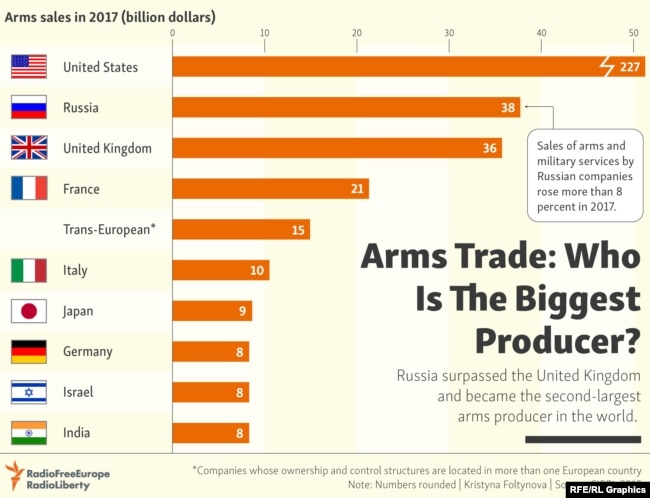
US Arms Makers Benefit as Sanctions Blunt
Russia’s Ability to Export Military Goods
Dave DeCamp / AntiWar.com & Joe Gould/ DefenseNews
(September 27, 2022) — Sanctions that make it harder for Russia to export military equipment create an “opportunity” for US weapons makers to find new markets, a White House official said at the arms industry conference ComDef on Tuesday.
“As a practical matter, countries that have had to rely on Russian equipment are going to find it very difficult to get even basic supplies from Russia’s defense industrial base,” Cara Abercrombie, the National Security Council’s director of defense policy and arms control, told the conference.
“It is an opportunity, certainly for industry members in the room. It is an opportunity for the United States to provide the support that these countries need,” Abercrombie added.
The Biden administration’s policy of supporting Ukraine in its war against Russia has been a total boon for the US arms industry. Besides profiting from the arms being sent to Ukraine, the industry stands to gain from former Soviet states phasing out their Russian-made equipment for NATO armaments.
Abercrombie said the US and its NATO allies were working to “rapidly transition” former Soviet states to NATO equipment and said there are also opportunities to arm countries in the Asia Pacific.
As part of this effort, the US recently announced $2.2 billion in Foreign Military Financing (FMF) for Ukraine and other countries in the region. FMF is a State Department program that gives foreign governments money to purchase US arms.
About $1 billion of the FMF will go to Ukraine, while the remaining funds will be divided among Albania, Bosnia, Bulgaria, Croatia, the Czech Republic, Estonia, Georgia, Greece, Kosovo, Latvia, Lithuania, Moldova, Montenegro, North Macedonia, Poland, Romania, Slovakia, and Slovenia.
US Sees Chance to Gain Arms Market Share from Sanctioned Russia
Cara Abercrombie, Deputy Assistant to the President and Coordinator for Defense Policy and Arms Control
WASHINGTON (September 27, 2022) — A White House official said Tuesday Russia’s sanctions-struck defense industry is creating an “opportunity” for U.S. and western defense firms to take a bite of Moscow’s share of the market.
“As a practical matter, countries that have had to rely on Russian equipment are going to find it very difficult to get even basic supplies from Russia’s defense industrial base,” Cara Abercrombie, the National Security Council’s coordinator for defense policy and arms control, told attendees of industry conference ComDef. “It is an opportunity, certainly for industry members in the room. It is an opportunity for the United States to provide the support that these countries need.”
The remarks come weeks after the Biden administration notified Congress it would make $2.2 billion in new Foreign Military Financing grants available for Ukraine and former Warsaw Pact countries whose Soviet-made gear has been part of international aid to Ukraine.
 “
“
In NATO, that could be to transition our eastern flank partners to NATO-standard, western equipment. But certainly as we look to other countries in the Pacific, this is an opportunity as well, not just for the United States, but for western industry as well,” Abercrombie said.
The Pentagon’s chief weapons buyer, Bill LaPlante, said more “interchangeability by interoperability” among allies presents an opportunity, not just economically, but geostrategically. Linking industrial bases, or “friendshoring,” would mitigate supply chain shocks and be essential to the common defense of the U.S. and its allies, he said.
“As we have seen in Ukraine, the weapons and equipment provided by the U.S. and its allies are the best in the world,” LaPlante said in pre-recorded remarks at the ComDef conference. “Continuing to more closely integrate these capabilities with increasingly common standards for munitions, software and other components will provide even greater advantages moving forward.”
Though western sanctions have targeted Russia’s defense industry, Russia was in 2021 the second-largest arms exporter after the United States, according to the Stockholm International Peace Research Institute. Its chief clients areIndia, China and Egypt.
The head of Russia’s weapons export branch said earlier this year that Moscow’s arms export revenue in 2022 is likely to total about $10.8 billion, roughly 26% lower than reported for 2021.
This week, LaPlante is in Brussels convening a meeting of weapons buyers from more than 50 countries to better coordinate defense industrial efforts as they replenish weapons sent to Ukraine from their own stockpiles. The meeting is taking place under the auspices of the 50-nation Ukraine Defense Contact Group.
Dovetailing with Pentagon-led efforts to boost western and allied defense capabilities, the White House will continue the work of a Department of Defense “tiger team” seeking to streamline the U.S. process of selling arms around the globe, Abercrombie said.

Russian arms industry competes for business.
“Within the National Security Council, I am looking at basically a baton pass,” Abercrombie said. “As DoD wraps up its initial analysis, we’ll be doing an interagency process to look at the collective [effort and] how can we make U.S. foreign military sales work better for our partners, or at least be a little faster.”
U.S. Defense Secretary Lloyd Austin in August established the task force to address the U.S. foreign military sales process, which spans the Pentagon and State Department. Abercrombie said the streamlining is meant to make the process more nimble without cutting corners.
Asked about trade restrictions by the European Union that could hinder U.S. defense exports, Abercrombie said the administration is seeking to reduce those barriers. Supply chain challenges make clear it’s “time to be looking for opportunities to work together to reduce the barriers,” she said.
The U.S.-led meeting of armaments directors in Brussels also highlights some of the headwinds for allied efforts to arm up. The gathering is aimed at addressing supply chain chokepoints for gun barrels, ball bearings and steel casings ― as well as how to sustain equipment for Ukraine on a long-term basis.
“Ultimately, more closely integrating with our allies and friends around the world will make us all more secure and resilient,” LaPlante said.
Sebastian Sprenger contributed to this report.
Joe Gould is the senior Pentagon reporter for Defense News, covering the intersection of national security policy, politics and the defense industry. He served previoUSy as Congress reporter.
Posted in accordance with Title 17, Section 107, US Code, for noncommercial, educational purposes.
